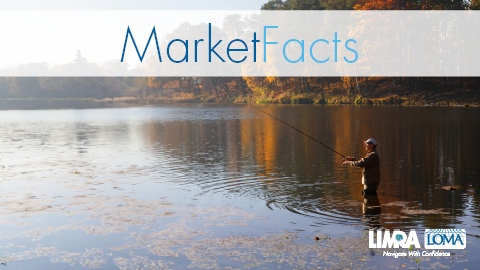Life Insurance Decisions: Keeping Consumers on Track

Life Insurance Decisions: Keeping Consumers on Track

November 2024
Many adults feel they do not have sufficient life insurance coverage — 30 percent of nonowners say they need coverage while 1 in 10 current owners say they need additional coverage, according to LIMRA’s 2024 Insurance Barometer Study. This “need-gap” represents a huge opportunity for the life insurance industry. However, to realize this opportunity, the industry must meet consumers where they are in terms of their readiness to make life insurance decisions.
To identify those consumers most at risk for suboptimal decisions, LIMRA classified consumers according to their life insurance decision state (Bateman et al., 2023) from pre-awareness of life insurance to feeling capable of making purchase decisions. Consumer characteristics associated with these states were also explored. These data can help maximize the effectiveness of strategies to increase life insurance coverage by identifying those consumers at greatest risk, the best time to target them for intervention and how to intervene.
About 1 in 10 consumers are pre-aware, acknowledging they do not know what life insurance is or how it works (Figure 1). Twelve percent feel they know what it is and how it works, but they are not interested in learning more about it. Four percent are open to learning more but are convinced they would not benefit from life insurance.
While 74 percent of consumers consider themselves capable of making life insurance purchase decisions, they vary in terms of the timing of their readiness to decide — about equal percentages have decided to continue with their current coverage, are in the process of deciding to purchase or will choose later. Five percent feel they will probably never get life insurance, or they no longer need it.
Pre-Aware |
I do not know what life insurance is, how it works and what it does. |
9% |
Aware |
I know what life insurance is, how it works and what it does, and I’m not interested in learning any more about life insurance or how it could benefit me. |
12% |
Interested |
I’m interested in learning more, but I’m pretty sure I / my beneficiaries would not benefit from it. |
4% |
Capable |
I’m pretty sure I / my beneficiaries would benefit from life insurance and . . . |
|
|
I will continue with the life insurance coverage I currently have. |
25% |
|
I’m currently looking at different life insurance coverage to decide what to choose. |
22% |
|
I looked at different life insurance coverage previously to decide whether to change, but I’m not ready to decide. |
22% |
|
Based on what I know now, I probably will never choose to get life insurance (don’t currently own) / I no longer need life insurance (currently own). |
5% |
Some factors promote awareness or interest but not capability. For example, while life events such as marriage, home purchase or the birth of a child are sufficient to trigger initial interest, specific knowledge about life insurance (product literacy) is needed to enable consumers to make decisions that are “right” for them. However, 52 percent of consumers report being not at all or only somewhat knowledgeable about life insurance. Of those not at all knowledgeable, more than half self-classify as pre-aware (see Figure 2). However, about 1 in 4 self-classify as capable meaning they have already purchased, or they are considering purchase. As these consumers lack product literacy, they are at considerable risk of making inadequate coverage decisions.
Seemingly, small increases in perceived knowledge make a big difference. The percentage of consumers who classify as capable increases to 7 in 10 for those somewhat knowledgeable about life insurance. Most of these capable consumers feel ready to choose now or later. However, for consumers who feel very or extremely knowledgeable, the largest segments say they will keep coverage they have already purchased, 53 and 67 percent, respectively. Financial literacy likely further enhances perceived capability.
How knowledgeable are you about life insurance?
Two obvious risks associated with the journey toward becoming a capable life insurance consumer are that (1) consumers will decide that life insurance isn’t for them without having sufficient knowledge to do so (the aware and interested groups) or (2) will proceed to capable decision states without sufficient product literacy or financial literacy to make the “right” coverage decisions for themselves.
Consumers between 18 and 24 years of age are one of the most likely groups to be pre-aware (18 percent). Therefore, this age range represents a critical window in which to convert consumers from pre-aware to capable before popular misconceptions or negative attitudes toward life insurance become entrenched. It is easier to help someone make up their mind than to try to change it. Seven percent of these younger consumers are aware but do not want to learn more about life insurance, while 5 percent are interested in learning more but are convinced life insurance will not benefit them. Furthermore, 70 percent of this age group feel capable of making a life insurance purchase decision. The good news is that even modest increases in perceived product literacy appear sufficient to move consumers further along in their decision journey and help them maintain an open mind toward considering life insurance. It can also protect younger consumers — whose interest in life insurance has been triggered by life events or other factors, but who have limited life insurance knowledge — from choosing inadequate coverage. Those who stand to benefit the most are those pre-aware (18 percent), those deciding now (21 percent), and those deciding later about their life insurance purchase (30 percent).
Life insurance is a complicated financial product that many consumers find difficult to understand. However, life events can prompt some consumers to consider purchasing before they sufficiently understand the product, leading to inadequate coverage. Others end their journey almost before it begins due to misconceptions or negative attitudes toward the product. Life insurers can help consumers stay on track and minimize the need gap by tailoring delivery of product-specific knowledge to the consumer’s decision state.

November 2024 Subscribe
Life Insurance Decisions: Keeping Consumers on Track
Putting a Number on It Helps Tell the Story
Winning the War on Talent Through Better Benefits
Delegating the Decision: ‘You Handle It for Us’
Building Better Employee Benefits Communications